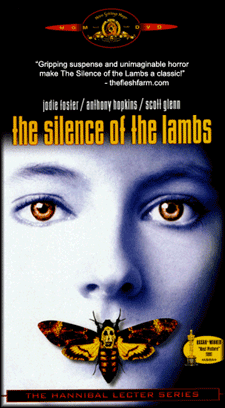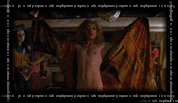


A
psychopath nicknamed Buffalo Bill is murdering young women across the Midwest.
Believing it takes one to know one, the FBI sends Agent Clarice Starling
to interview a demented prisoner who may provide clues to the killer's
actions. That prisoner is psychiatrist Dr. Hannibal Lecter, a brilliant,
diabolical cannibal who agrees to help Starling only if she'll feed his
morbid curiosity with details about her own complicated life. As their
relationship develops, Starling is forced to confront not only her own
hidden demons but also an evil so powerful that she may not have the courage
- or strength - to stop it!

"Tell me, Clarice
- have the lambs stopped screaming?"
- Hannibal Lecter |

Very seldom has the horror film genre made such a leap forward into achievement as it did with
The Silence of the Lambs. The brooding psychosis of the film, combined with the intricate plot and aesthetics of a crime thriller, provided the perfect scenario for a balls-to-the-wall horror show to become a near-universal critical success. By delving into the realm of psychology, it obtains a grasp of what people really fear, and showcases these ideas in some of the most sadistic, yet remarkably sophisticated, ways imaginable. In other words, it gets into your head and stays there, because nothing is more fearful than the perfect depiction of evil that is portrayed in such a realistic manner throughout the film.
Thomas Harris has constructed a marvelously putrid storyline revolving around the chase of a sadistic serial killer and a startling relationship between an FBI cadet and another, incarcerated killer who his helping her. Clarice Starling, the cadet, is helping FBI director Jack Crawford find the serial killer, Buffalo Bill, by confiding in Hannibal Lecter. Of course, since the plot has since become iconic, it hardly seems necessary to detail the story any further.
The real standouts are the characters, which are magnificently formed by Jodie Foster, Anthony Hopkins, and Ted Levine, particularly in the case of Hopkins. As every review of this film will indicate, it’s impossible not to discuss
The Silence of the Lambs without mentioning Hopkins’ performance. He develops Hannibal Lecter into something more than just a cannibalistic murderer. Hopkins’ demeanor, standing with an intent stare and voice that epitomizes the sound of restrained evil, helps create one of the most memorable character introductions in movie history. He is polite, courteous, and sophisticated, yet his mere presence invokes the feeling of malevolence and evil. This demeanor is kept throughout the film, and is played so masterfully that Hannibal becomes an intensely likable character, despite the fear that accompanies him each time he is seen onscreen.
On the opposite side is Clarice Starling, the ambitious, yet palpably vulnerable and slightly naïve heroine. Although Foster’s performance contributes tremendously to the compassion and emotion the audience feels for her, Jonathan Demme creates an environment equally responsible for setting Starling up as one of the most enduring and unexpected heroes of all-time. The film utilizes all the available space to make Clarice seem as vulnerable and exposed as possible. Twice in the film she is left alone with overbearing male police officers, creating sexual tension thick enough to grab out of the screen. Even more so, she confides in a man so dangerous that it is equally palpable, and his obvious obsession with her creates an even eerier atmosphere, even after he escapes. Simply put, Starling is surrounded by figures who wish to have her, use her, exploit her, and manipulate her, easily allowing her to gain the audience’s support in a fight against insanity and brutal misogyny.
Lecter’s previously mentioned escape is the pivotal point in the film, culminating into an ultimate hypocrisy. As examined earlier, Lecter is a villain that the audience “roots” for; his creepiness is extremely memorable, and his sophistication is likable. The aid he provides to Agent Starling against a common, equally psychotic enemy is all the more reason to support Hannibal. We wish for him to escape during his attempt, never wanting him to be finished, yet his freedom is feared at the same time. The murder of several police officers and civilians to make his getaway is terrifying and brutal, and fear for Clarice’s well-being becomes inherent. The danger and hostility of Dr. Lecter is always present, no matter how likable a villain he is.

Finally, there is the common “enemy” between the two, Buffalo Bill. Bill becomes an almost tragic character, so torn apart and abused throughout his life that he has resorted to skinning women as a last resort to help him forget his identity. However, he is also completely wicked and unforgivable, lacking the enjoyable eeriness of Lecter, and becomes a vent for the audiences’ hate that they should feel for both men. Equal parts writing, direction, and performance provides this unlikely scenario and becomes one of the most unforgettable achievements. If
The Silence of the Lambs will ever be topped, it won’t be by pure horror. The incredible psychology of the film must be used again in a situation that allows for the same wonder, suspense, and terror to be so perfectly mixed.
 |
|  |
| 
 |
|  |
| 

- Gene Hackman was first offered the role of Hannibal Lecter, and
was set to direct, but he withdrew after watching a clip of himself in Mississippi
Burning at the The 61st Annual Academy Awards, which made him uneasy
about taking more violent roles. When Jonathan Demme took over as director,
he offered the role of Clarice first to Michelle Pfeiffer and also to Meg
Ryan.
- Then Secretary of Labor, Elizabeth Dole's, Washington, D.C. office doubled
for that of the F.B.I. director's office in the movie.
- The Tobacco horn worm moths used throughout the film were given celebrity
treatment by the filmmakers. They were flown first class to the set (in
a special carrier), had special living quarters (rooms with controlled
humidity and heat) and were dressed in carefully designed costumes (body
shields bearing a painted skull & crossbones)
- A large part of the shoot took place in Pittsburgh. The city was chosen
for its variety of landscapes and architecture, which was necessary to
portray various parts of the country. All the film's interiors were constructed
and shot in an abandoned Pittsburgh factory.
- Only the third movie to win all five major Oscars: Best Picture, Best Director,
Best Actor, Best Actress, and Best Screenplay. The others were Frank Capra's It
Happened One Night and One Flew Over the Cuckoo's Nest.
- Anthony Hopkins described his voice for Hannibal Lecter as, "a combination
of Truman Capote and Katharine Hepburn."
- After the shootout with Gumb, Starling has partially burned gunpowder buried
in the skin on the side of her face, the result of a near-miss. One name
for this type of injury is "coal miner's tattoo" - a clever reference to
the character's background.
- Upon close inspection, the butterfly in the posters for the movie
appears to have a human skull at its center. However, upon very close inspection,
this "skull" turns out to be at least three naked women (clearly seven
in some versions of the poster) and is very similar to a 1951 photograph
by Philippe Halsman, inspired by a Salvador Dalí drawing and gouache
painting.
- Buffalo Bill is the combination of three real life serial killers:
Ed Gein, who was skinning his victims; Ted Bundy, who used the cast on
his hand as bait to make women get into his van; and Gary Heidnick, who
kept women he kidnapped in a pit in his basement.
- George A. Romero has a cameo as the bearded man who accompanies
Chilton and the two guards who forcibly remove Clarice Starling after her
final meeting with Lecter.
- In his first meeting with Clarice Starling, Lecter describes the
drawing on his cell wall as "the Duomo, seen from the Belvedere" in Florence,
Italy. Starling later finds Buffalo Bill living in Belvedere, Ohio. Lecter,
in fact, gives her Buffalo Bill's location in their first meeting.
- In Hannibal's last words to Clarice before Dr. Chilton has her
removed, he stresses the word "simplicity". This was not just an urging
to her to keep things simple, but was a reference to the dress pattern
company Simplicity.
- When Jonathan Demme filmed the scene where Lecter and Starling
first meet, Anthony Hopkins said he should look directly at the camera
as it panned into his line of sight. He felt Lecter should be portrayed
as "knowing everything."
- Anthony Hopkins invented the fast, slurping-type sound that Hannibal
Lecter does. He did it spontaneously during filming on the set, and everyone
thought it was great. Director Jonathan Demme became annoyed with it after
a while, but denied his irritation.
- The first moth cocoon found in one of the victim's throats was
made from a combination of "Tootsie-Rolls" and gummy bears, so that if
she swallowed it, it would be edible.
- The film originally was going to be released in the fall of 1990.
However, Orion pictures, which distributed the film, decided instead to
delay its release until January 1991 so that it could concentrate all their
efforts in promoting Dances with Wolves for Oscar consideration.
- In preparation for his role, Anthony Hopkins studied files of
serial killers. Also, he visited prisons and studied convicted murderers
and was present during some court hearings concerning serial killings.
- With less than 16 minutes of screen time, Anthony Hopkins's performance
was the shortest ever to win a leading acting Oscar.
- Note Lecter's mention of having consumed a victim's liver with,
specifically, fava beans and chianti. Liver, fava beans, and wine all contain
a substance called tyramine, which can kill you if you're talking a certain
class of antidepressant drugs known as MAO inhibitors. MAO inhibitors were
the first antidepressant drugs developed, and were used primarily on patients
in mental institutions ... and Lecter both worked in, and was committed
to, a mental institution.
- A corpse in the movie is found suspended from the ceiling of Lecter's
cell, arrayed in what is known as a "blood eagle", which was a method of
torture and execution in ancient Scandinavia. It involved the removing
the skin of a man's back, crushing his ribs, then removing the lungs through
the back. The lungs would then be arranged about the shoulders or arms
to make them appear as wings.
- In preparation for their roles, homemade audio tapes that serial
killers had recorded while torturing and killing captured victims were
made available to both Jodie Foster and Scott Glenn. Foster declined to
listen to the tapes, and Glenn regretted having done so because he couldn't
forget what he had heard.




























